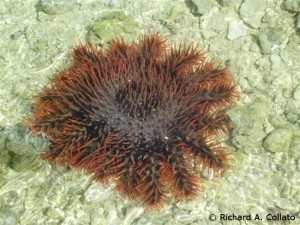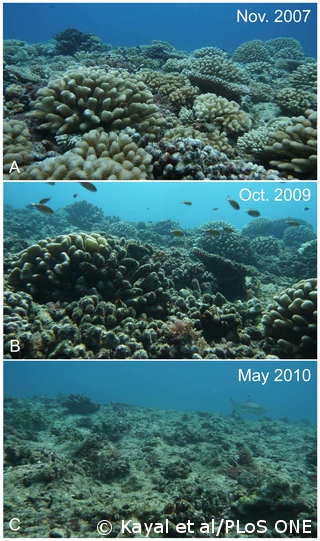In this latest blog in the threats to corals series, we discuss the crown-of-thorns starfish, a voracious coral predator whose populations can rapidly expand to epidemic proportions, decimating reef habitats on a localised scale.
Acanthaster planci, better known as the crown-of-thorns starfish (CoT), is a colossal starfish and notorious predator of reef building corals.

Reaching perhaps one metre across, these marine invertebrates possess a distinctive and intimidating appearance. Each animal has between 7 and 23 arms which radiate around a disc shaped, central body. Adorned on top of their fleshy structure are hundreds of vicious looking spines, each several centimetres long and loaded with stinging toxins to deter potential predators. The starfish can range in colour from dull grey to bright purple and has a gruesome feeding habit in which it inverts its stomach out of its mouth and over its prey, releasing enzymes to digest the soft living tissue.
CoT starfish are one of the few natural predators of hard corals. In normal conditions, they persist in sustainable, low density populations and, due to their preference for consuming fast growing species, play an ecologically important role in maintaining coral diversity. Under certain circumstances however, populations of these corallivorous animals can boom to reach unsustainable densities. With a single starfish capable of consuming a ‘dinner plate sized’ area of coral in a single night (that equates to 10m2 of coral reef over the course of a year), these outbreaks can decimate reefs as living corals are consumed many times quicker than they can grow. Additionally, over-predation of the CoT stars’ preferred prey species often results in localised coral extinctions, thus leading to changes in reef community structure. In severe outbreaks, coral species will be sequentially lost until there is no living coral remaining.
Whilst CoT outbreaks have probably occurred naturally – but rarely – throughout history, the issue today is that the frequency of these outbreaks has greatly increased in recent decades. What was once perhaps a one in ever eighty year event now occurs every fifteen years, leaving reefs little time to recover.

The feeding strategy of the CoT starfish allows the animal to digest live coral tissue without damaging the physical reef structure. Nonetheless, without living tissue, colony skeletons become brittle and more vulnerable to physical disturbance. Subsequent freak weather events have been found to inflict catastrophic damage to reefs suffering from CoT outbreaks.
So what causes these outbreaks and how can they be stopped? The current theory is that population expansion is facilitated by an increased level of nutrients in the surrounding water.
CoT larvae typically settle in deeper waters at the base of reefs. Here larval forms can feed on phytoplankton and micro-algae in the water column. The availability of these food sources is closely tied to the survival of larvae into the juvenile form, at which point their diet diversifies and they can begin to consume coralline algae and, eventually, reef building corals. Elevated water nutrient levels have been found to coincide with CoT outbreaks and research has shown that higher nutrient levels – as a result of flooding/sediment run-off/fertiliser leaching etc – leads to higher levels of phytoplankton and in turn, greater survivorship of CoT larvae. Considering that a single female starfish can release a staggering 50 million eggs a year, the impact of increased larval survivorship can be enormous.
CoT outbreaks are considered a significant but potentially manageable threat to many coral ecosystems. Unlike the threats of global warming and ocean acidification, outbreaks of this predatory starfish are a result of localised coastal management and as such can be dealt with without the need for challenging international collaboration. The Australian government for example has embarked on an AU$200 million Reef Rescue programme to monitor and reduce nutrient run-off along the coastlines of its Great Barrier Reef, a coral habitat that has suffered numerous CoT outbreaks in recent decades. Only time will tell if such management can successfully prevent or mitigate outbreaks in the future.